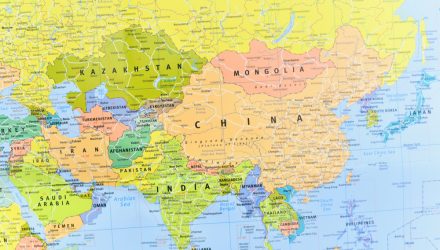Fixed income investors who are looking to diversify their portfolios should consider the benefits of exposure to Asia’s high-yield bond market, along with one actively managed bond exchange traded fund strategy that provides exposure to this enticing yet overlooked asset class.
In the recent webcast, Is it High Time for Asia High Yield in Your Bond Allocation?, Brendan Ahern, CIO, KraneShares, outlined the opportunity in Asian high-yield debt markets. He noted that the Asia bond market has witnessed steady growth over the last decade. The JPMorgan Asia Credit Index also expanded from a market capitalization of $250 billion in 2010 to over $1.1 trillion in March 2022, or an increase of 346%.
However, Ahern argued that Asia debt is largely underrepresented in many fixed income portfolios. Despite Asia ex-Japan representing nearly one-third of global GDP, the region makes up only 12% of the Bloomberg Global Aggregate Index.
Consequently, many investors are missing out on an alternative high yield-generating category. Asian high-yield issuers boast attractive interest coverage ratios. In 2021, the average interest coverage ratio, or EBITDA to interest expense, for Asian high-yield issuers was 5.5x. Generally speaking, an interest coverage ratio of 2x is considered acceptable and an interest coverage ratio of 3x is considered good.
Many emerging Asian countries’ real yields appear more attractive compared to the U.S. and Japan. Both high-yield and investment-grade spreads in Asia are currently attractive compared to spreads in the U.S. and Europe. Over the past 10 years, Asia high-yield bonds have offered an average yield of approximately 7%, and durations tend to be lower than broad emerging markets and U.S. high yield. A lower duration means the value of a bond is less impacted by a change in interest rates.
Ahern also noted that Asia debt issuance has been growing over the past six years, averaging $69 billion annually, revealing that companies are confident in their futures and financing future growth.
Furthermore, Asia high-yield corporate bonds have a relatively low default rate compared to other global high-yield markets. The default rate of Asia high-yield corporate bonds has been lower than that of high-yield bonds in other emerging markets regions in seven of the past 11 years and was lower than the U.S. high-yield default rate in both 2019 and 2020.
“Asia high yield offers relatively high yield with good credit quality that includes non-rated bonds from high-quality issuers in Asia,” Ahern said.
To help investors access this opportunity set, Ahern highlighted the KraneShares Asia Pacific High Yield Bond ETF (KHYB), an actively managed fund that provides broad exposure to high-yield bonds from the Asia-Pacific region. The fund actively invests in high-yield debt securities of any maturity issued by governments and corporations from the Asia-Pacific region, including both emerging and developed countries.
Nikko Asset Management Americas Inc., the sub-advisor, uses top-down macro research and bottom-up credit research to construct its portfolio, incorporating a proprietary process that combines quantitative and qualitative factors to assess an issuer’s credit profile, along with an assessment of a security’s value and relative value compared to other similar securities.
Peter Graf, deputy CIO, Nikko Asset Management Americas, Inc., underscored the desynchronized cycles in Asia that reflect independent growth and credit cycles compared U.S. markets. In other words, the asset category offers diversification benefits with lower correlation to traditional U.S. fixed income assets.
Graf also pointed to the high-income opportunity and cheaper relative value compared to expensive valuations in the rest of the world. When fixed income investors are faced with elevated prices in most developed markets, Asian debt offers relatively cheaper market exposure compared to their fundamentals, along with attractive yields to boot.
“The Asia high-yield bond market currently offers higher yields than other global high-yield bond markets. As of March 2022, Asia high-yield bonds had a yield of 9.7% compared to 5.8% for U.S. high-yield bonds,” Ahern added.
Ahern also argued that active management is a better way to help investors access these Asian fixed income markets. An active manager may offer local expertise, familiarity with issuers, the ability to invest tactically based on market conditions and individual issuers’ circumstances, the ability to base investments off credit quality, and a research-driven investment process guided by investment professionals.
“We believe that active management is appropriate for investing in Asia high-yield bonds given the market’s size, complexity, and tendency to undergo rapid changes owing to the low level of development of some of its country constituents,” Ahern said.
Financial advisors who are interested in learning more about Asia high-yield bonds can watch the webcast here on demand.

